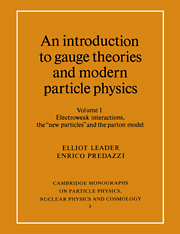Book contents
- Frontmatter
- Contents
- Preface
- Acknowledgements
- Notational conventions
- Note added in proof: the discovery of the top quark (?)
- Note added in proof: the demise of the SSC
- 1 Field theory and pre-gauge theory of weak interactions
- 2 The need for a gauge theory
- 3 Spontaneous symmetry breaking: the Goldstone theorem and the Higgs phenomenon
- 4 Construction of the standard model
- 5 Lowest order tests of the SM in the leptonic sector
- 6 The Higgs boson
- 7 The standard model beyond lowest order
- 8 e+e− physics and the standard model
- 9 Extension to the hadrons; quark–lepton universality
- 10 Phenomenology of semi-leptonic reactions
- 11 The discovery of the narrow vector resonances
- 12 Hidden flavour bound states
- 13 Open heavy flavours
- 14 The heavy lepton τ
- 15 Towards the parton model—deep inelastic scattering
- 16 The quark–parton model
- 17 Experimental tests of the quark-parton model
- Appendix 1 Elements of field theory
- Appendix 2 Feynman rules for QED, QCD and the SM
- Appendix 3 Conserved vector currents and their charges
- References
- Analytic subject index for vols. 1 and 2
3 - Spontaneous symmetry breaking: the Goldstone theorem and the Higgs phenomenon
Published online by Cambridge University Press: 19 March 2010
- Frontmatter
- Contents
- Preface
- Acknowledgements
- Notational conventions
- Note added in proof: the discovery of the top quark (?)
- Note added in proof: the demise of the SSC
- 1 Field theory and pre-gauge theory of weak interactions
- 2 The need for a gauge theory
- 3 Spontaneous symmetry breaking: the Goldstone theorem and the Higgs phenomenon
- 4 Construction of the standard model
- 5 Lowest order tests of the SM in the leptonic sector
- 6 The Higgs boson
- 7 The standard model beyond lowest order
- 8 e+e− physics and the standard model
- 9 Extension to the hadrons; quark–lepton universality
- 10 Phenomenology of semi-leptonic reactions
- 11 The discovery of the narrow vector resonances
- 12 Hidden flavour bound states
- 13 Open heavy flavours
- 14 The heavy lepton τ
- 15 Towards the parton model—deep inelastic scattering
- 16 The quark–parton model
- 17 Experimental tests of the quark-parton model
- Appendix 1 Elements of field theory
- Appendix 2 Feynman rules for QED, QCD and the SM
- Appendix 3 Conserved vector currents and their charges
- References
- Analytic subject index for vols. 1 and 2
Summary
We here discuss dynamical systems in which the ground state does not possess the same symmetry properties as the Lagrangian. When this happens in certain field theories one finds that there inevitably exist massless scalar bosons, the so-called Goldstone bosons. Remarkably, however, when this happens in a local gauge theory involving massless vector fields and scalar fields, the would-be Goldstone bosons disappear, but contrive to re-emerge disguised as the longitudinal mode of the vector fields, which thereupon behave like massive vector bosons with three spin degrees of freedom. In this way the unwanted massless vector bosons of the gauge theory are replaced by heavy vector mesons as demanded by the phenomenology of the weak interactions.
It is well known that a considerable simplification obtains in a problem whenever the interaction possesses some symmetry. Exact symmetries, such as electric charge conservation, are, however, fairly rare in nature, and the usual way of representing the situation is to assume that a small piece of the Lagrangian violates a particular symmetry whereas the rest of ℒ is invariant. Thus strong interactions conserve parity, isospin and strangeness, whereas electromagnetic interactions violate isospin, and weak interactions violate isospin, strangeness and parity, so that a hierarchy of forces results. A very interesting situation occurs when the solutions of a problem are not symmetric in spite of the Lagrangian being exactly symmetric—in particular if this is so for the ground state of the system. One then talks, somewhat inappropriately, of a ‘spontaneously broken symmetry’. The most celebrated classical example is a ferromagnet.
- Type
- Chapter
- Information
- Publisher: Cambridge University PressPrint publication year: 1996
- 1
- Cited by



